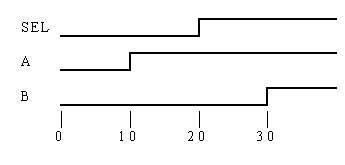Last month, we looked at describing stimuli in Verilog to test our 2-input multiplexer. So this month, we’ll llok at how to capture the response of our device under test.

Remember from the module template that we are using initial blocks to code up the Stimulus and Response blocks.
module MUX2TEST; // No ports!
...
initial
// Stimulus
... MUX2 M (SEL, A, B, F);
initial
// Analysis
...
endmodule
The Response initial block can be described very easily in Verilog as we can benefit from a built-in Verilog system task. Thus:
initial // Response $monitor($time, , SEL, A, B, F);
Once again, let’s look at each item in turn.
$monitor();
$monitor is a system task that is part of the
Verilog language. Its mission in life is to print values to the
screen. The values it prints are those corresponding to the
arguments that you pass to the task when it is executed. The
$monitor task is executed whenever any one of its arguments
changes, with one or two notable exceptions.
$time
$time is a system function (as opposed to a system
task). It returns the current simulation time. In the above
example, $time is an argument to $monitor. However, $time
changing does not cause $monitor to execute — $monitor is
clever enough to know that you wouldn’t really want to print
to the screen the values of all of the arguments every time the
simulation time changed.
, ,
The space at position 2 in the argument list
ensures that a space is printed to the screen after the value of
$time each time $monitor is executed. This is a simple method of
formatting the screen output.
SEL, A, B, F
Finally we come to the signal arguments themselves.
Each time one of these signals changes value, $monitor will
execute. When $monitor executes it will print all of the argument
values to the screen, including $time. This is the output created
by $monitor in our MUX2 testbench:
0 0000
10 0101
20 1100
30 1111
This is simply a tabular listing of the waveforms that would be generated during simulation (if we had a waveform viewer, that is!).

It’s amazing what you can learn from two lines of code, isn’t it? We’ll look at more elaborate output formatting soon.
Next month, following on from our overview in February, we’ll look at writing synthesizable Verilog code...
![]() Verilog
FAQ
Verilog
FAQ
![]() Doulos Training Courses
Doulos Training Courses
![]() Return to
Hardware Designers Guide Contents
Return to
Hardware Designers Guide Contents
Copyright 1995-1998 Doulos
This page was last updated 4th October 1998
![]() We welcome your e-mail comments. Please contact us at: webmaster@doulos.co.uk
We welcome your e-mail comments. Please contact us at: webmaster@doulos.co.uk